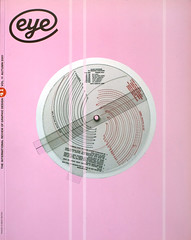Autumn 2001
Fading away before the issues
SuperHumanism
D&AD conference, 29 May 2001, Church House, Westminster, London.<br>This £400 one-day symposium aimed to instigate ‘an overdue overhaul of the very principles of business, brands and institutions, their use of technology, and the way they relate to consumers.’ Translated into a one-liner this became ‘You have one day to save humanity’, a statement that makes the First Things First 2000 call for a mindshift towards ‘a new kind of meaning’ restrained in comparison. The roster of speakers, including Naomi Klein, Malcolm Garrett, John Warwicker and John Maeda, were generally everything you might expect, delivering speeches that detailed individual concerns and hobby-horses. The energetic Maeda suffered technical shortcomings that required him to deliver his talk, unseen by most of us, from a high balcony while the images from his laptop were displayed on screen. Neville Brody recited grim statistics while stock photo images of middle class homes played behind.
Historian Theodore Zeldin was particularly engaging: you felt he would have said something worthwhile how-ever dumb the initial topic. The Q&A sessions were another thing altogether. One questioner, baldly promoting the name of his company, asked a question about ‘the companies you work with’, Klein, stumped for a moment, replied: ‘I don’t work with companies.’ The distinction between writer and copy-writer seemed to evade some of the audience. ‘The needs of society and economy are out of sync,’ said Mark Leonard. ‘There isn’t much space for thinking … this is why companies are not capable of answering questions that are being asked by the public.’
Dan Wieden was as smart and easy on the ear and eye as your favourite US TV show, but said little when it came to the question of ‘bullying brand’', and the anti-globalisation riots that occurred on his doorstep in Seattle. When audience member Peter York, pushed him to recount his ‘plague diaries’ (after all, Wieden & Kennedy’s client Nike is almost the No Logo Antichrist), he grinned and shrugged. One longed for Naomi Klein to join the debate, but she was already on a plane back to North America. As an example of his firm’s expertise, Wieden showed a short, hip-hop / basketball video made by a colleague. It was a smart, sharp and technically dazzling piece of virtuoso film-making, with no perceptible branding … except for a few not-so-subliminal frames where the ball, marked clearly with the notorious swoosh, zoomed in to fill the field of vision. Possibly the most inept piece of product placement of the year.
The conference logo, designed by Farrow, looked pretty in graduated tints from pink to yellow (attendees were divided into ‘pink’ and ‘yellow’ sides). In monochrome, on every name badge, photocopy and fax, the logo provided its own critique, fading away in shades of grey. There wasn’t much of an ‘ism’, and the ‘Human’ relevance was ambiguous.
John L. Walters, Eye editor, London
First published in Eye no. 41 vol. 11, 2001
Eye is the world’s most beautiful and collectable graphic design journal, published quarterly for professional designers, students and anyone interested in critical, informed writing about graphic design and visual culture. It is available from all good design bookshops and online at the Eye shop, where you can buy subscriptions and single issues.

